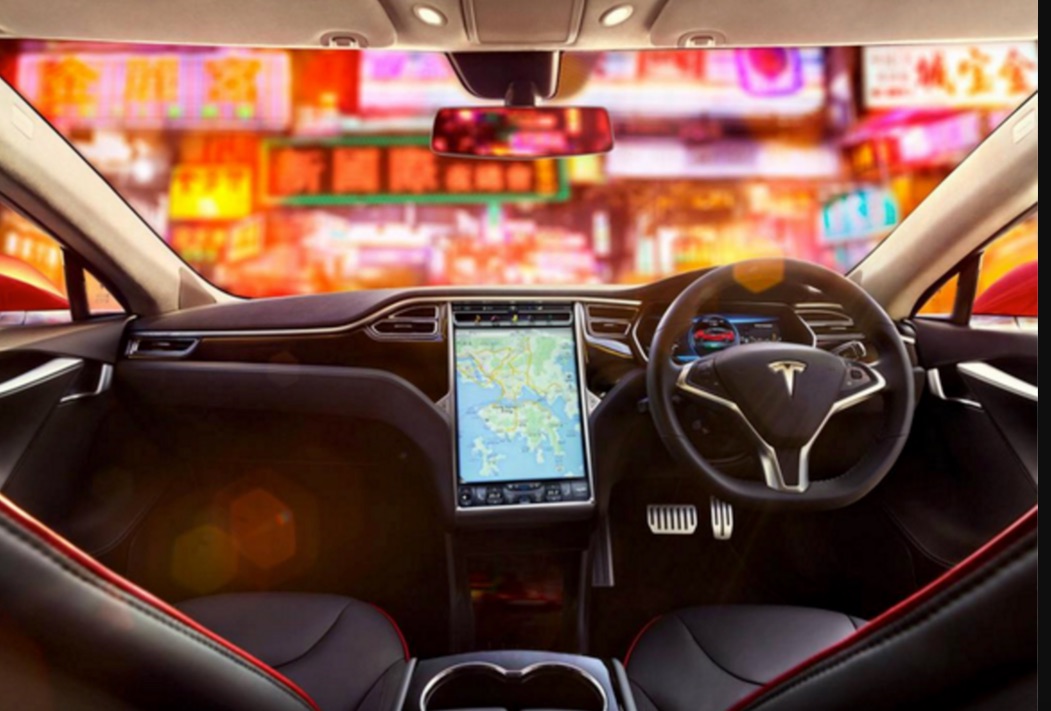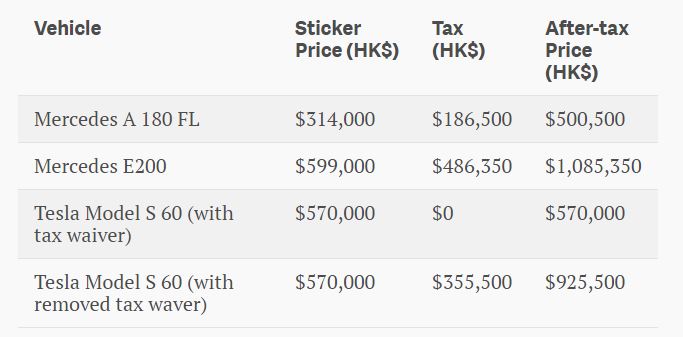News
Tesla and Hong Kong: Once ideal companions for a city of contrasts

Luxury automobile owners in Hong Kong have enthusiastically embraced the Tesla brand over the past three years. In large part, that’s because Tesla vehicles were not part of the pool of new car purchases that incurred a tax often equal to or exceeding a car’s full sticker price. Tesla had benefited from a nearly twenty year old exemption from this tax as part of the electric vehicle category.
However, the allure of a Tesla as a luxury car with great value and zero emissions may be fading for Tesla consumers.
During a speech about the annual budget for 2017, financial secretary Paul Chan announced that the government will lift a long-standing waiver for electric cars on new vehicle registration taxes. It will be replaced by a maximum deduction that is equivalent to about $12,500 U.S. As there had been so few electric car choices in the Hong Kong market, the original heavy tax on new private car purchases, which had been imposed as a measure to mitigate emissions and reduce traffic, really didn’t amount to much lost tax revenue for the government in its early years.
That is, until Tesla came to town. Car buyers soon found that it could purchase an automobile with the panache of a Mercedes but spend about half the amount. Tesla owners would also have the added benefit of feeling better about their contributions to a city that suffers from heavy air pollution.
Hong Kong’s love for Tesla
Hong Kong is a fascinating place. Calm and orderly crowds. Ample green spaces interspersed between and on top a vertical city. Open land just on the city outskirts. An area that feels like one giant interconnected shopping mall with a density of luxury brand stores. Three Tiffany’s Flagship stores. Eight Hermès shops. Thirteen Armani stores and the Armani Nightclub. In Hong Kong, the new and contemporary complement the ancient and traditional: temples beside skyscrapers, luxury shops flanking Chinese pharmacies, double-decker trams and mini-buses puttering alongside Teslas.
The Tesla brand has fit nicely into the Hong Kong cultural melting pot of neon signs and urban landscape. With networking as an integral part of life and thirty-somethings working and playing hard in a hedonistic lifestyle, Tesla arrived in Hong Kong at the right time. A top tax bracket on income set at 17.5% didn’t hurt sales, either.
Electric vehicle (EV) registrations in Hong Kong catapulted in the last few years. That affection for EVs may be coming to an end now that the government is revising the regulations that inspired their popularity. The new legislation will alter a Tesla Model S 60 with a sticker price of price of $570,000 HK ($73,000 USD) to a cost total of $925,500 HK ($120,000 USD). That means there would be little or no price advantage to purchase a Tesla over a Mercedes. It remains to be seen whether Tesla will still have appeal due to its now-established strong brand, its inherent zero petrol costs, and its ability to contribute to lower pollution levels.
A Tesla spokesperson says that the company is “disappointed” with the government’s new measure:
“Over the past few years, the impressive growth in all kinds of electric vehicles on Hong Kong’s roads has helped create a cleaner, more sustainable city without increasing congestion as almost all our new owners are replacing a particularly high-polluting fossil fuel vehicle. [The action] threatens to move Hong Kong backwards. We will continue to support our owner community and will work with all our current order holders to ensure the delivery of their vehicles with full FRT exemption.”
Here is the cost breakout for Hong Kong luxury car purchases under the new measures.

Image courtesy of Quartz

Elon Musk
Starlink passes 9 million active customers just weeks after hitting 8 million
The milestone highlights the accelerating growth of Starlink, which has now been adding over 20,000 new users per day.

SpaceX’s Starlink satellite internet service has continued its rapid global expansion, surpassing 9 million active customers just weeks after crossing the 8 million mark.
The milestone highlights the accelerating growth of Starlink, which has now been adding over 20,000 new users per day.
9 million customers
In a post on X, SpaceX stated that Starlink now serves over 9 million active users across 155 countries, territories, and markets. The company reached 8 million customers in early November, meaning it added roughly 1 million subscribers in under seven weeks, or about 21,275 new users on average per day.
“Starlink is connecting more than 9M active customers with high-speed internet across 155 countries, territories, and many other markets,” Starlink wrote in a post on its official X account. SpaceX President Gwynne Shotwell also celebrated the milestone on X. “A huge thank you to all of our customers and congrats to the Starlink team for such an incredible product,” she wrote.
That growth rate reflects both rising demand for broadband in underserved regions and Starlink’s expanding satellite constellation, which now includes more than 9,000 low-Earth-orbit satellites designed to deliver high-speed, low-latency internet worldwide.
Starlink’s momentum
Starlink’s momentum has been building up. SpaceX reported 4.6 million Starlink customers in December 2024, followed by 7 million by August 2025, and 8 million customers in November. Independent data also suggests Starlink usage is rising sharply, with Cloudflare reporting that global web traffic from Starlink users more than doubled in 2025, as noted in an Insider report.
Starlink’s momentum is increasingly tied to SpaceX’s broader financial outlook. Elon Musk has said the satellite network is “by far” the company’s largest revenue driver, and reports suggest SpaceX may be positioning itself for an initial public offering as soon as next year, with valuations estimated as high as $1.5 trillion. Musk has also suggested in the past that Starlink could have its own IPO in the future.
News
NVIDIA Director of Robotics: Tesla FSD v14 is the first AI to pass the “Physical Turing Test”
After testing FSD v14, Fan stated that his experience with FSD felt magical at first, but it soon started to feel like a routine.

NVIDIA Director of Robotics Jim Fan has praised Tesla’s Full Self-Driving (Supervised) v14 as the first AI to pass what he described as a “Physical Turing Test.”
After testing FSD v14, Fan stated that his experience with FSD felt magical at first, but it soon started to feel like a routine. And just like smartphones today, removing it now would “actively hurt.”
Jim Fan’s hands-on FSD v14 impressions
Fan, a leading researcher in embodied AI who is currently solving Physical AI at NVIDIA and spearheading the company’s Project GR00T initiative, noted that he actually was late to the Tesla game. He was, however, one of the first to try out FSD v14.
“I was very late to own a Tesla but among the earliest to try out FSD v14. It’s perhaps the first time I experience an AI that passes the Physical Turing Test: after a long day at work, you press a button, lay back, and couldn’t tell if a neural net or a human drove you home,” Fan wrote in a post on X.
Fan added: “Despite knowing exactly how robot learning works, I still find it magical watching the steering wheel turn by itself. First it feels surreal, next it becomes routine. Then, like the smartphone, taking it away actively hurts. This is how humanity gets rewired and glued to god-like technologies.”
The Physical Turing Test
The original Turing Test was conceived by Alan Turing in 1950, and it was aimed at determining if a machine could exhibit behavior that is equivalent to or indistinguishable from a human. By focusing on text-based conversations, the original Turing Test set a high bar for natural language processing and machine learning.
This test has been passed by today’s large language models. However, the capability to converse in a humanlike manner is a completely different challenge from performing real-world problem-solving or physical interactions. Thus, Fan introduced the Physical Turing Test, which challenges AI systems to demonstrate intelligence through physical actions.
Based on Fan’s comments, Tesla has demonstrated these intelligent physical actions with FSD v14. Elon Musk agreed with the NVIDIA executive, stating in a post on X that with FSD v14, “you can sense the sentience maturing.” Musk also praised Tesla AI, calling it the best “real-world AI” today.
News
Tesla AI team burns the Christmas midnight oil by releasing FSD v14.2.2.1
The update was released just a day after FSD v14.2.2 started rolling out to customers.

Tesla is burning the midnight oil this Christmas, with the Tesla AI team quietly rolling out Full Self-Driving (Supervised) v14.2.2.1 just a day after FSD v14.2.2 started rolling out to customers.
Tesla owner shares insights on FSD v14.2.2.1
Longtime Tesla owner and FSD tester @BLKMDL3 shared some insights following several drives with FSD v14.2.2.1 in rainy Los Angeles conditions with standing water and faded lane lines. He reported zero steering hesitation or stutter, confident lane changes, and maneuvers executed with precision that evoked the performance of Tesla’s driverless Robotaxis in Austin.
Parking performance impressed, with most spots nailed perfectly, including tight, sharp turns, in single attempts without shaky steering. One minor offset happened only due to another vehicle that was parked over the line, which FSD accommodated by a few extra inches. In rain that typically erases road markings, FSD visualized lanes and turn lines better than humans, positioning itself flawlessly when entering new streets as well.
“Took it up a dark, wet, and twisty canyon road up and down the hill tonight and it went very well as to be expected. Stayed centered in the lane, kept speed well and gives a confidence inspiring steering feel where it handles these curvy roads better than the majority of human drivers,” the Tesla owner wrote in a post on X.
Tesla’s FSD v14.2.2 update
Just a day before FSD v14.2.2.1’s release, Tesla rolled out FSD v14.2.2, which was focused on smoother real-world performance, better obstacle awareness, and precise end-of-trip routing. According to the update’s release notes, FSD v14.2.2 upgrades the vision encoder neural network with higher resolution features, enhancing detection of emergency vehicles, road obstacles, and human gestures.
New Arrival Options also allowed users to select preferred drop-off styles, such as Parking Lot, Street, Driveway, Parking Garage, or Curbside, with the navigation pin automatically adjusting to the ideal spot. Other refinements include pulling over for emergency vehicles, real-time vision-based detours for blocked roads, improved gate and debris handling, and Speed Profiles for customized driving styles.








